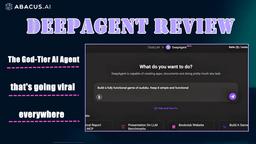Abacus.AI Howto
Abacus.AI is the world's first AI-assisted end-to-end data science and MLOps platform that enables organizations to build and deploy custom AI systems and agents using state-of-the-art LLMs and machine learning capabilities.
View MoreHow to Use Abacus.AI
Choose a Product: Select between ChatLLM (for professionals/small teams) or Abacus.AI Enterprise (for larger organizations)
Create an Account: Sign up on the platform using your email or Google account credentials
Select Use Case: Choose from available use cases like AI Agents, Forecasting, Anomaly Detection, Vision AI, Predictive Modeling, or Personalization
Data Integration: Upload or connect your data sources using the Python SDK or API. Map your data correctly into the system to create Machine Learning features
Create Feature Groups: Organize your datasets into feature groups using SQL queries or the platform interface
Configure Training Parameters: Set up general and advanced training configuration options for your ML model based on your use case
Train Models: Initialize the training process using the configured parameters. The AI engine will train both your model and a baseline model
Evaluate Results: Review model performance metrics and visualizations provided by the platform
Deploy Model: Deploy trained models to production using the platform's deployment tools
Monitor Performance: Track model performance, drift, and real-time predictions using the platform's monitoring tools
Abacus.AI FAQs
Abacus.AI is an enterprise-grade AI-assisted end-to-end machine learning platform that serves as an AI Brain for organizations. It offers services including custom chatbots, AI agents, forecasting, personalization, and predictive modeling.
Abacus.AI Monthly Traffic Trends
Abacus.AI achieved 3.5M visits with a 7.5% increase in traffic. The release of ChatLLM Teams in April 2025, which offers advanced collaboration and productivity features, likely contributed to this growth.
View history traffic
Related Articles
Popular Articles

FLUX.1 Kontext Review 2025: The Ultimate AI Image Editing Tool That Rivals Photoshop
Jun 5, 2025

FLUX.1 Kontext vs Midjourney V7 vs GPT-4o Image vs Ideogram 3.0 in 2025: Is FLUX.1 Kontext Really the Best AI for Image Generation?
Jun 5, 2025

How to Create Viral Talking Baby Podcast Videos with AI: Step-by-Step Guide (2025)
Jun 3, 2025

Best 5 NSFW Characters Generator in 2025
May 29, 2025
View More










